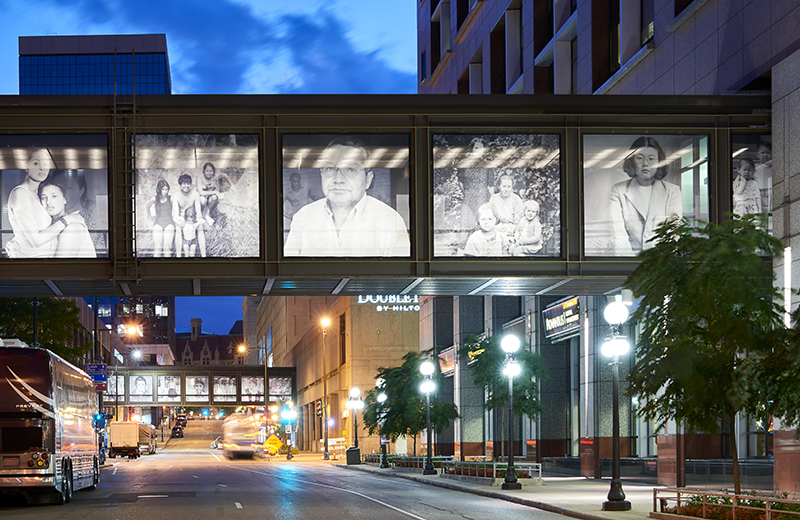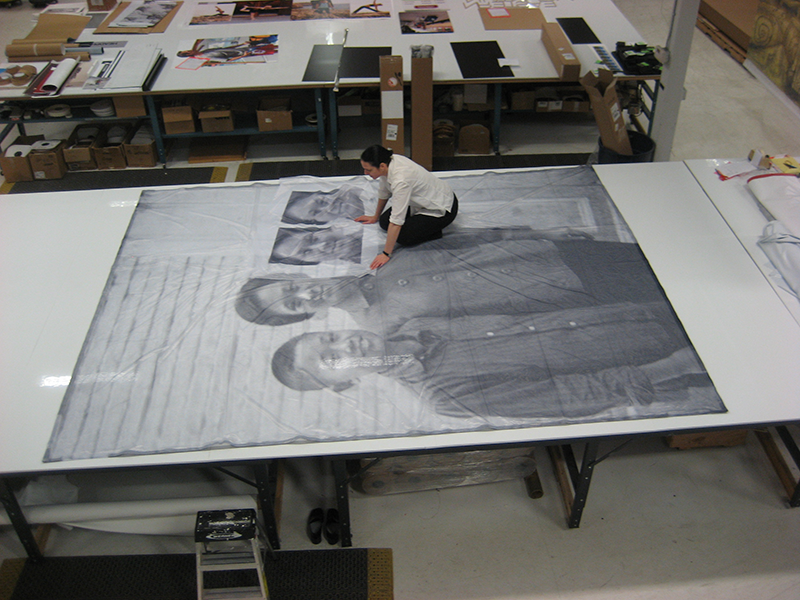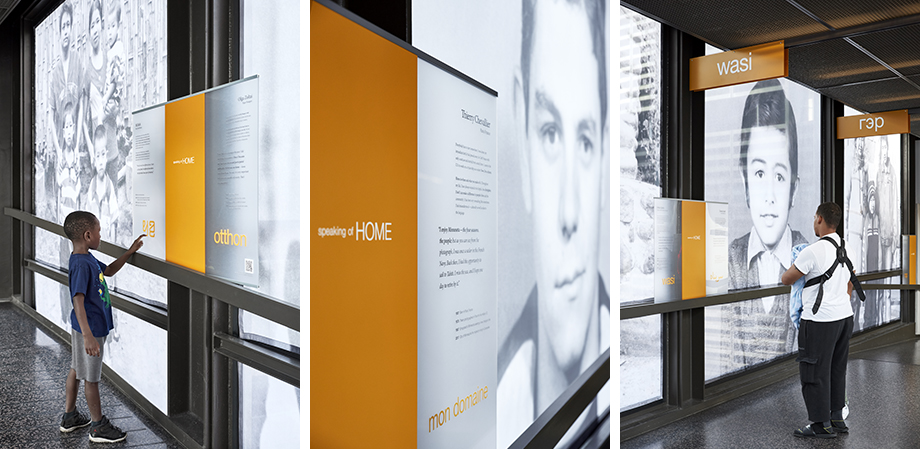
Photo: Peter Von De Linde
How do our cities demonstrate a “welcome” to immigrants and refugees? The kind of welcome that makes them feel at home? Can public art play a role in that welcome? Certainly murals, signage, exhibits of immigrant artist works, and other examples exist.
When artist Nancy Ann Coyne moved from New York City to Saint Paul, she looked up. She saw the Skyways. While other cities have them, the Twin Cities are known for their winter-friendly network of passageways that float above and connect many of the major downtown buildings. As a photographer, journalist, designer, and public artist who focuses on social impact, Coyne was also moved by the intense diversity of the immigrant and refugee population, where over 120 languages are spoken.
The Twin Cities are an exemplary melting pot, and in a moment when acceptance, tolerance for the very idea of immigration, and safe passage for refugees all seem to be melting, she took her experience in creating large-scale public artworks and decided to take a stand. She met with, interviewed, photographed, and videotaped over 60 people with the aim to integrate photography as narrative documentary, and storytelling into an immersive experience. She wanted to celebrate Saint Paul’s immigrants and decided to attempt to literally elevate their stories to the Skyways, where the citizenry could experience them as they passed by—up close and personal. But first she had to get permission.
This project was the antithesis of a slam-dunk. Anyone who knows Coyne knows her to be relentlessly focused, a persistent advocate for her project. Along with a team that resembled a real estate developers office—zoning lawyers, architects, project managers, and many others since 2009, Coyne literally willed this project into existence.
While I never met Christo, I can imagine he was equally determined. Nancy falls into that tradition: the tradition of using the landscape—the world as it is—as a gallery space, a stage to show something new that provokes, inspires new perceptions, and challenges our assumptions.
The faces and stories of immigrants from over 55 countries comprise the Speaking of Home installation, which is now open. Coyne was very conscious of the role of light as an element of the installation. The exhibition was constructed in the interiors of a set of the skyways that join major buildings in Saint Paul as galleries, windows, with the floor to ceiling portraits looking out to street and in to the passageway.
“Coyne invites the viewer into their world, and the challenges they have faced coming to a foreign place and making it their own.” —Tom Fisher, University of Minnesota2017 marks the 50th anniversary of the skyway system in Saint Paul. For 50 years, the only function of the Saint Paul skyways has been to move pedestrians, as ordinances prohibit their use for anything other than foot traffic. While the skyways are publicly owned, the buildings connecting them are private. Coyne worked with four city departments, the City District Council for the downtown (District 17), and four private property owners to get buy-in and support to issue a permit for her project.

Photo: Designtex
Public art may be the most challenging form of art-making. First you have to have a willingness to deal with the constraints and politics of zoning, public officials, city councils, civil engineers, property owners, non-profits, funders, local media, and…then implement, install and perform your work in public. On July 6th, 2016, Nancy Ann Coyne, assisted by Steve Carpenter, CEO of Archetype, Michael Haug, design director and Carol Lansing, attorney at Faegre Baker Daniels, created with the Saint Paul City Council, a new ordinance to enable the skyway to be permitted for Speaking of Home and for future artwork installations. The City of Saint Paul, and all of its beautifully diverse citizenry, owes her a debt of gratitude for making their home a home for art in the sky.
Reflecting on what she’s learned in this eight year journey, Coyne says
Speaking of Home demonstrates how, as creative professionals, we have the tools to change urban planning policies and design new experiences to democratize and add value to the public domain; moreover, we can impact not only the public’s experience of a place—but how one feels and behaves towards one another.Speaking of Home could have been subtitled, “What it feels like to be here.” Psychologist Paul Ekman’s research told us decades ago that the face was the screen for emotions. And that no matter where you are from—how different, diverse, or difficult your family of origin was, we all share a common set of emotions: fear, anger, shame, sadness, and joy.
When randomly interviewing on site, I’m astounded how the project resonates viserally with viewers throughout the ethnic and class spectrum—homegrown or immigrant.

Photo: Peter Von De Linde
The exhibit is a visual testament to the inclusiveness of the Saint Paul community. The many people in power who had to say “yes” have included these newcomers in the fabric of the city. Their images speak: “These immigrants belong.” “Refugees are welcome.” Speaking of Home makes the obvious profound. This is their home. They are with us.
The Chilean neuro-biologist, Humberto Maturana, wrote in his classic, The Tree of Life, that acknowledgement—the act of truly recognizing an “other”—is the biological form of love. By working for years to realize her vision for Speaking of Home, Coyne has written a very visible public love letter to our newest neighbors, people we can get to know and befriend, and in doing so, used art in a profound way to say, “Welcome.”
Speaking of Home was created in partnership with the City of Saint Paul and the firm Archetype in association with the University of Minnesota, District 17, Forecast Public Art, and Springboard for the Arts. Major funders include the National Endowment for the Arts, Minnesota State Arts Board, Knight Foundation, McKnight Foundation, Metropolitan Regional Arts Council.
